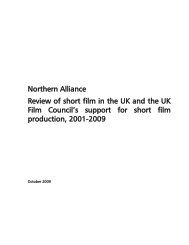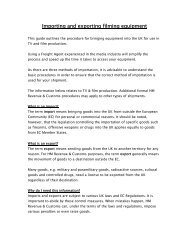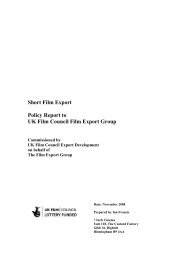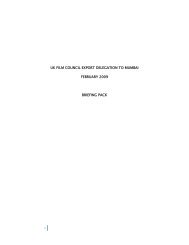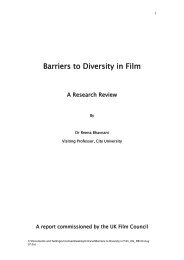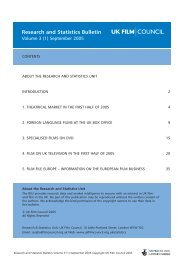Developing an environmental strategy for UK film - BFI
Developing an environmental strategy for UK film - BFI
Developing an environmental strategy for UK film - BFI
You also want an ePaper? Increase the reach of your titles
YUMPU automatically turns print PDFs into web optimized ePapers that Google loves.
Flooding, sea level rise, extreme weather events, water availability <strong>an</strong>d the relocation of urb<strong>an</strong><br />
populations <strong>for</strong> example, will have a severe impact on the whole of the <strong>film</strong> industry, from l<strong>an</strong>d<br />
availability <strong>an</strong>d loss of locations <strong>for</strong> <strong>film</strong>ing, resource scarcity, restrictions on the freedom of<br />
movement, increased hostilities from the flurry of <strong>environmental</strong> refugees, damage to business 10<br />
<strong>an</strong>d rising insur<strong>an</strong>ce premiums. Moreover, as the cost of flood defences escalate, through<br />
mainten<strong>an</strong>ce <strong>an</strong>d upgrading existing flood defences <strong>an</strong>d building new flood defences, there is a<br />
risk that funding resources <strong>an</strong>d <strong>film</strong> tax incentives may be redirected to compensate <strong>for</strong> the ever<br />
exp<strong>an</strong>ding flood defence budget <strong>an</strong>d depleting public purse. In fact, one could deduce that the<br />
true scale of the impacts of climate ch<strong>an</strong>ge could cause the eventual collapse of the <strong>film</strong> industry<br />
if climate ch<strong>an</strong>ge is not tackled on a global scale (not just within the <strong>film</strong> industry). There<strong>for</strong>e,<br />
the <strong>film</strong> industry by taking a st<strong>an</strong>ce to combat climate ch<strong>an</strong>ge could use its power of<br />
communication to increase awareness on a global scale.<br />
Environmental Concerns: Natural Resource Use<br />
Natural resources are naturally occurring subst<strong>an</strong>ces; they c<strong>an</strong> be renewable <strong>an</strong>d non-renewable.<br />
The <strong>UK</strong> Government groups natural resources in five overlapping ways 11 : -<br />
1. Raw materials such as minerals <strong>an</strong>d biomass: Minerals (fossil fuels, metal ores, gypsum<br />
<strong>an</strong>d clay) are classed as non-renewable because they c<strong>an</strong>not be replenished within a<br />
hum<strong>an</strong> timescale. Biomass is renewable within the hum<strong>an</strong> timeframe <strong>an</strong>d includes<br />
agricultural crops <strong>an</strong>d slowly renewable resources like timber. 12<br />
2. Environmental media such as air, water <strong>an</strong>d soil: Resources which sustain life <strong>an</strong>d<br />
support biological resources.<br />
3. Flow resources such as wind, geothermal, tidal <strong>an</strong>d solar energy: Resources which c<strong>an</strong>not<br />
be depleted, but require other resources to exploit them. For example, energy, materials<br />
<strong>an</strong>d space are needed to build wind turbines or solar cells.<br />
4. Space: L<strong>an</strong>d <strong>for</strong> wildlife, rivers <strong>an</strong>d natural processes <strong>for</strong> them to function healthily, <strong>an</strong>d<br />
l<strong>an</strong>d <strong>for</strong> cities, towns, infrastructure, industry <strong>an</strong>d agriculture.<br />
5. Biological resources: Pl<strong>an</strong>ts, <strong>an</strong>imals <strong>an</strong>d other org<strong>an</strong>isms maintain the life-sustaining<br />
systems of the earth. Biodiversity (variety of life on earth) is also a resource <strong>an</strong>d includes<br />
the diversity within species, between species <strong>an</strong>d of ecosystems.<br />
If renewable resources are consumed at a rate that exceeds their natural rate of replacement the<br />
resource will diminish <strong>an</strong>d eventually run out, however, if they are used sustainably they c<strong>an</strong>, to a<br />
certain extent, be used indefinitely. Non-renewable resources exist in a fixed amount <strong>an</strong>d c<strong>an</strong>not<br />
be remade, regrown or regenerated, there<strong>for</strong>e c<strong>an</strong>not be used indefinitely.<br />
Pressures on the availability <strong>an</strong>d use of natural resources are increasing. During the past 50 years<br />
the hum<strong>an</strong> population has increased from two to seven billion people. With the soar in<br />
population, economic development <strong>an</strong>d increased consumption hum<strong>an</strong>s are using 20% more<br />
natural resources each year th<strong>an</strong> c<strong>an</strong> be regenerated. Resource use is often inefficient, both in<br />
production <strong>an</strong>d consumption; approximately 80% of products are discarded after a single use.<br />
10 Zurich insur<strong>an</strong>ce conducted a study during 2006 <strong>an</strong>d found 30,000 small to medium businesses suffered from floods at a cost of £86 million<br />
11 http://www.sustainable-development.gov.uk/key/whatare-natural.htm<br />
12 Although <strong>UK</strong> <strong>for</strong>est cover is increasing due to re<strong>for</strong>estation <strong>an</strong>d sustainable m<strong>an</strong>agement of woodl<strong>an</strong>ds, over 45% of the Earth’s original <strong>for</strong>est cover has<br />
been lost mostly during the last century.<br />
Version 1.0 - 14 -



